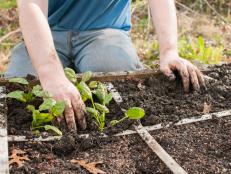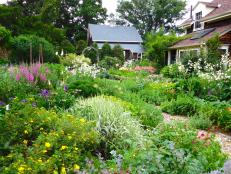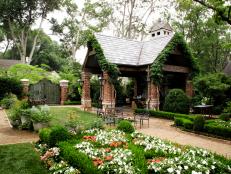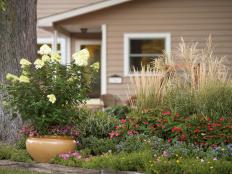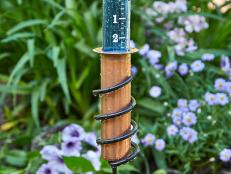Up in the Air: Rooftop Gardens

It isn't enough that rooftop gardeners have to worry about the weight of potting soil and how many elevator trips it will take to schlep two bags of amendments, a flat of marigolds and a small crabapple tree. They also have heat, drought and drying winds to worry about. Whether your garden is 12 stories up or on a backyard patio, their advice can help you cope:
Make smart plant choices

"A rooftop garden is exposed. It's almost like a beach environment — hot, dry and windy," says Carmen DeVito, a landscape designer in Brooklyn, N.Y. "So I use a plant palette like I would at a beach house." In her rooftop designs, she uses bayberry (Myrica pensylvanica, a common coastal plant), roses (especially 'The Fairy'), herbs, grasses (Miscanthus sinensis 'Yakujima'), succulents, yarrow, pines (like Pinus mugo), dwarf junipers, cotoneaster and Russian olive.
Lots of rooftop gardeners grow tomatoes, coleus and other thirsty plants. If you know you're going to be able to water once or twice a day as necessary, go for it. If not, choose drought-tolerant plants such as lantana, portulaca, euphorbia and grasses. Mediterranean-type plants, including herbs like rosemary, lavender and thyme, also withstand drought.

Look especially for heat tolerance in your plant selections. Plants like Dahlberg daisy (Dyssodia tennuiloba), globe amaranth (Gomphrena globosa) and gazania (Gazania rigens) regularly make the "hot" list.
Also seek plants that don't need to be deadheaded or that create much litter. If you're gardening in a spot where a compost pile isn't possible, the less maintenance you have to do — and the less debris you have to get rid of — the better.
Provide some shade if you can
The ambient temperature of an urban setting builds up as heat is absorbed and reflected from a jungle of hard, concrete surfaces. If you can, grow vines up a trellis, add a patio umbrella or even build a pergola to reduce the amount of sun shining on your garden floor. "Or you can construct shade with metal posts and sailcloth," says Joan Grabel, a landscape designer in Studio City, Calif.
Provide water and good drainage
Install an irrigation system, especially drip irrigation, says DeVito. "Watering is the single most important gardening chore, and on a rooftop you may have to water up to twice a day." With an irrigation system, all you have to do is set a timer to water and check the system periodically.
If you don't have an irrigation system, remember the rule of watering — water well whenever you water. It takes time for potting soil to fully absorb water, so water slowly or rewater about 30 minutes later.
Account for drainage. Direct runoff away from the main area where people will gather.
Other tips
- Use larger-sized containers rather than smaller ones. They retain moisture better, plus they're heavier in weight (so they're less likely to topple over in the wind). With fewer but larger pots, says DeVito, "there's easier maintenance, less evaporation and a cleaner look." Containers limit rootball size. As long as the plant gets enough water, it will adapt.
- Use a lightweight soil mix designed for containers — one that includes perlite or vermiculite. DeVito uses a mix that has shredded bark, vermiculite and peat moss, and then adds pure compost to the mix.
- Use organic fertilizer so nutrients don't leach out as quickly. Slow-release fertilizers are a good choice.
- Mulch the soil surface to conserve moisture and keep soil temperature consistent.
Rooftop (or balcony or deck) gardeners have to consider how much weight the structure can support. If you're planning to do some significant gardening or hardscaping, says DeVito, "work with the building engineer and review the building codes to see what's allowed. Codes limit what types of materials can be used." If you're renting, you probably won't be able to (or want to) provide any structural reinforcements.
Spectacular Rooftop Gardens
See All PhotosEcoroofs

Turning rooftops as green as possible only makes good environmental sense, says David Yocca, landscape architect and planning director of the Conservation Design Forum in Elmhurst, Ill., a firm that designs ecoroofs. The ecoroofs are lined with special materials, topped with a lightweight blend of soil, compost and perlite, and planted with anything from small grasses to eight-foot conifers. Irrigation systems on timers dispense water on a regular basis.
"It's good from an ecological and human health standpoint," Yocca says. "It's a way to manage [runoff] in a positive way and it minimizes chemicals."
Plus, plants evapotranspire, Yocca explains, and that "creates natural air conditioning, so you don't have an urban heat island. An ecoroof protects the building against heat loss in winter and heat gain in summer." Since plants convert carbon dioxide into oxygen, ecoroofs also improve air quality. In several cities, ecoroof advocates like Yocca are working to have green roofs become common practice. In Europe, they're already fairly common; in Switzerland new buildings are required to have on their roofs the same amount of vegetation they replaced.









